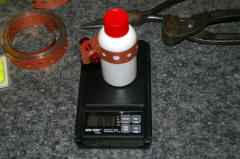
Coolant Recovery System for MX bikes
Demonstrated on 1990 KTM 500 MX
updated March 31, 2010
The way it works is the same as the coolant recovery system on your car: When the coolant expands due to the motor heating up some will come out of the radiator vent fitting. It will go into the coolant recovery tank (the little bottle, in this case) and the air it displaces goes out the vent line. When the motor cools off the coolant retracts and the radiator cap allows the system to pull back in through the radiator vent fitting, in our case pulling coolant out of the bottle so the radiator remains full of coolant. Without the recovery system the cooling motor pulls in air when it cools off, and the radiator becomes less full. This isn't too great of a problem for a static motor, as it will reach equilibrium while the radiator is still pretty full. The problem is that on a dirt bike, when you are getting heat into the engine you are usually riding, and that means the coolant is splashing around in the radiator. Whenever coolant is splashed on the radiator vent, it is expelled, only to be replaced by air when things cool again. Each cycle you loose a little more. That's why I use a tube for the vent on the tank, when coolant splashes up at the vent, it is captured by the vent line and hopefully will drain back into the tank. Presently I see coolant at the vent line after a ride, so I may end up using 1/4" to help air get out without pushing out coolant due to surface tension. I'll update when I know more about this.
I started by trying to find a small container to use as a coolant recovery tank. This is a 5 hour energy drink bottle, the kind carried by Walgreens. As you can see, I'm using a metal strap for the mount (available at Lowe's or Home Depot in the plumbing section), and attaching it with some aluminum hardware from my spares. The KTM has a 6mm x1 threaded hole just below the radiators on the frame, used for the center brace for the large desert gas tanks. Most folks don't use the brace even if they have the large gas tank, and I just do MX so had no problem dedicating the hole to this system. I tightened the screw to the right pressure on the strap holding the bottle, then tightened the nut against the frame to hold the whole deal in place.
Here you can see the bottle attached to the frame. Initially I was going to use 1/4" tubing, but that proved too big to go through the small bottle cap. I switched to 1/8" tubing, and it seems to work fine. The tube from the radiator needs to be set up so that it goes right to the bottom of the bottle so it will pull coolant back into the radiator when the scooter cools down. The other tube is cut off just below the cap, as it is simply a vent line.
The radiator obviously still needs a 1/4" line, so I got a drop of coolant on the end of the 1/8" line and got it to slide into the 1/4" one. There is no pressure in these lines, so you don't have to worry about them blowing apart or anything. Just the friction fit is working fine on my bike... so far! My good friend Doug has done one of these in the past, and he tells me that some MX bike radiator caps do not have the second gasket. I had one like that on my bike, but thought it was defective. I got my spares out, had two rad caps, and they both had both gaskets. If you are doing this, it's important that the radiator cap has a rubber sealing gasket inner radiator cap seal, and also one for the outer radiator cap seal. See labeled picture above.
And that's it. Doesn't stick out in harms way or weigh enough to worry about. The coolant it keeps in your radiator will weigh a lot more than this system! So far I've had no problems with the bottle melting, but it's still cool outside. We'll see how it goes on those sweltering summer evening rides, I may have to find a bottle rated for higher temperatures. I'll keep this page updated if/when things change.